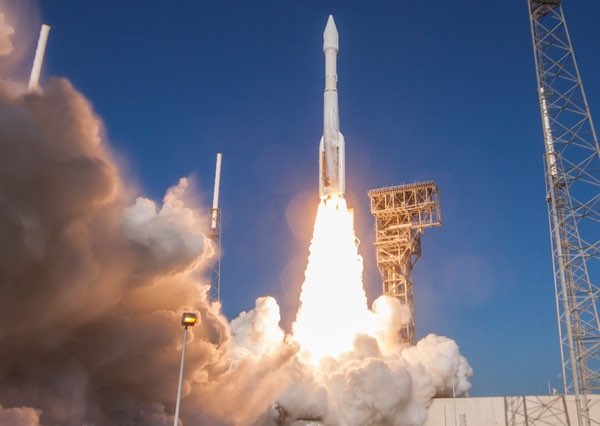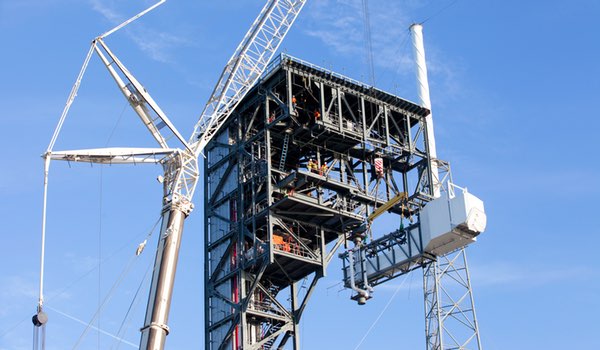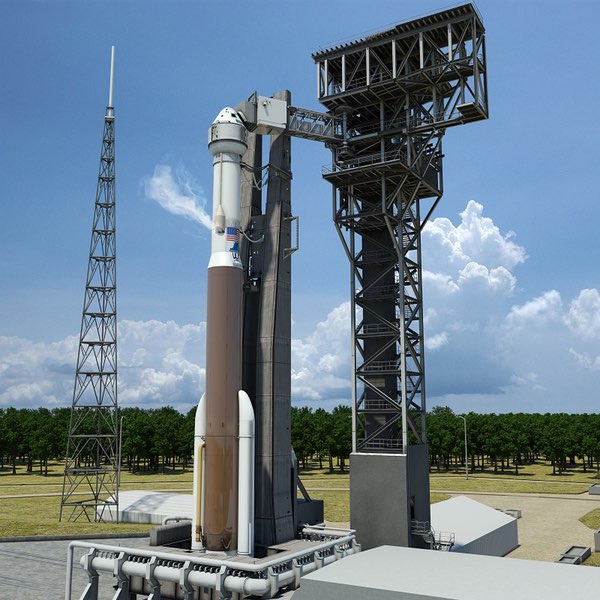Human-rating the Atlas V Centaur for NASA’s commercial crew programby Anthony Young
|
| ULA will provide documentation and data to NASA demonstrating the Atlas V launch vehicle and Centaur upper stage will be utterly reliable and safe to transport crews to the ISS. |
That reliance will end when SpaceX with its Falcon 9 rocket and Crew Dragon capsule, and the United Launch Alliance (ULA) Atlas V with Boeing’s CST-100 Starliner capsule, return this capability to American soil. SpaceX will launch crews from the reconfigured LC-39A complex at Kennedy Space Center, and ULA will launch from its Space Launch Complex 41 (SLC-41) at Cape Canaveral Air Force Station.
In August 2009, NASA’s Commercial Cargo and Crew Program Office (C3PO) issued its requirements for human-rated launch vehicles and crew transportation spacecraft to industry. The involved down-selection process to two commercial crew services providers has been the subject of numerous articles here since then.
In September 2014, NASA announced the two winners of the Commercial Crew Transportation Capability (CCtCap) contracts, SpaceX and Boeing. SpaceX had designed the Falcon 9 and Dragon capsule for potential use on human spaceflight missions from the beginning. The ULA Atlas V and Centaur upper stage, though, have launched only commercial and military satellites payloads. ULA is incorporating an Emergency Detection System (EDS) and will provide documentation and data to NASA demonstrating the Atlas V launch vehicle and Centaur upper stage will be utterly reliable and safe to transport crews to the ISS. The burden of proof is no less for SpaceX and its launch vehicle and capsule.
 An Atlas 5 lifts off from SLC-41 on a recent mission, with the tower that will be used for crewed missions in the background. That tower was built in segments between Atlas V launches there. (credit: ULA) |
Human-rating the Atlas prior to and after ULA formation
The Atlas V, developed by Lockheed Martin, and the Delta IV, developed by Boeing, are products of the US Air Force’s Evolved Expendable Launch Vehicle (EELV) program. Both Atlas and Delta launch vehicles have been payload workhorses for decades, launching commercial and military satellites and NASA space probes.
The Atlas V shares just its original name with the intercontinental ballistic missile (ICBM) developed for the Air Force over half a century ago. Atlas ICBMs were human-rated for five of the seven Project Mercury orbital flights. Eventually, the Atlas ICBM was decommissioned and the existing missiles were converted to launch vehicles. The Atlas underwent several redesigns with regard to its propulsion and structure over a period of many years.
Since 1962, the Atlas has flown with the Centaur high-energy upper stage using liquid oxygen (LOX) and liquid hydrogen (LH2) propellants for either the single engine configuration (SEC) or dual engine configuration (DEC) incorporating the RL10 engine manufactured today by Aerojet Rocketdyne. The Centaur has also been used on Titan launch vehicles. Six RL10s powered the S-IV upper stage of the Saturn I during the Apollo program. This Centaur was also once planned for use on the shuttle, but later abandoned.
The first Atlas V, powered by the NPO Energomash RD-180 engine burning LOX and RP-1, first launched in August 2002. Human-rating studies of the Atlas V started with NASA’s Orbital Space Plane (OSP) program in 2003 and 2004. NASA worked closely with Lockheed Martin Space Systems to establish criteria and supplemental systems to satisfy human rating requirements for the Atlas V to transport the OSP. Although that spacecraft was never realized, those studies laid vital groundwork for human-rating the Atlas V.
| In the six years since ULA received that award, ULA progressed well beyond the concept stage, to an EDS undergoing qualification testing. |
Due to the superior launch performance of the Atlas V (400 series) with the addition of up to three solid rocket boosters, only single-engine Centaur upper stages have been needed. For application in the Commercial Crew program, ULA has been working to develop and certify the DEC on the Atlas V to deliver the CST-100 Starliner to the ISS. The DEC has flown over 160 missions on Atlas and Titan launch vehicles. The Atlas V DEC will add significantly to mission success and crew safety.
In May 2005, Boeing and Lockheed Martin announced plans to establish a joint venture, United Launch Alliance, that would bring the Atlas V and Delta IV under one umbrella. The joint venture was formally created in December 2006.
After NASA issued its requirements for commercial crew in 2009, Boeing began working on crew capsule design concepts for what was assigned the alphanumeric designation CST-100, for the Crew Space Transportation system. As early as 2007, the Atlas V had been the launch vehicle chosen by SpaceDev for its Dream Chaser spacecraft in a memorandum of understanding with ULA. Sierra Nevada acquired SpaceDev in 2008. The Atlas V had a flawless launch history, and it would be the launch vehicle of choice for several companies that would be competing for crew launch services with NASA.
In 2010, NASA awarded ULA $6.7 million, with ULA contributing and additional $1.3 million, to develop a proof-of-concept EDS for the Atlas V as a first step in human-rating the launch vehicle for commercial crew services to the ISS. The Atlas V, along with its Centaur upper stage, was already certified by NASA for Category 3 deep space planetary missions such as New Horizons to Pluto and the soon-to-be-launched Juno probe to Jupiter, now orbiting the planet.
In the six years since ULA received that award, ULA progressed well beyond the concept stage, to an EDS undergoing qualification testing. The EDS, according to ULA, “…only monitors those potential LV [launch vehicle] events that are Criticality 1 crew safety hazards. The key function of the EDS is to notify the crew of an impending or occurring degrading condition as soon as detected and issue an abort signal to the spacecraft when the situation becomes critical.”
At the same time, however, ULA has designed the EDS to sense false indications of primarily propulsion systems, but also other anomalies that might otherwise trigger an abort command from a perfectly operating booster. ULA wants the EDS to be “fault tolerant” to prevent an unnecessary abort to also preserve mission success.
In July 2011, ULA signed an unfunded Space Act Agreement (SAA) with NASA whereby the space agency would provide ULA with technical knowledge from its human spaceflight programs to draft human-rated certification requirements for launch vehicles. In turn, ULA would provide to NASA documentation and performance data on its launch vehicles and their ability to adopt the certification requirements for human spaceflight in support of the Crew Transportation System. By this time, Blue Origin had also selected the Atlas V as the launch vehicle for its proposed biconic crew capsule.
“This unfunded SAA will look at the Atlas V to understand its design risks, its capabilities, how it can be used within the context of flying our NASA crew and maturing ULA’s designs for the Emergency Detection System and launch vehicle processing and launch architectures under a crewed configuration,” said Ed Mango, NASA’s commercial crew program manager at the time of the announcement.
July 2011 also marked the end of NASA’s human spaceflight program using the shuttle. STS-135 was commanded and piloted by Christopher Ferguson, who is now responsible for Boeing’s CST-100 crew and mission operations.
 Earlier this month, workers installed the crew access arm on the new tower at SLC-41. (credit: NASA/KSC) |
Boeing partners with ULA
In August 2011, Boeing announced its selection of the Atlas V/Centaur as the launch vehicle for its proposed CST-100 crew capsule as part of the NASA’s Commercial Crew Development (CCDev) program in its bid to win future NASA flight contracts. The previous April, Boeing had won a $93 million CCDev-2 award from NASA to further develop its proposed crew capsule design.
| “For human spaceflight, the increased thrust of the [dual-engine Centaur] allows the trajectory to be ‘flattened’ to provide a safer reentry environment for the crew in the unlikely event of a crew abort situation,” Sowers said. |
Boeing’s Defense, Space, and Security division has been working with ULA toward an integrated launch vehicle and spacecraft system. The CST-100 will have a compact service module, with its primary function of providing the needed pusher-type launch-abort system powered by four Aerojet Rocketdyne RS-88 engines. The 4.53-meter diameter CST-100 service module would mate to an adapter for interface to the 3.05-meter diameter Centaur upper stage. The Atlas V has a diameter of 3.81 meters, requiring a tapered interstage for the Centaur.
By February 2012, ULA had completed the third and fourth mandated milestones of its CCDev agreement. These were the Tailored System Requirements Review (TSRR) and the Probabilistic Safety Analysis review (PSA). The TSRR provided to NASA detailed documentation that demonstrated the flight-proven Atlas V met the intent of NASA’s Human Spaceflight Certification requirements. The PSA review provided information documenting safety-critical launch vehicle systems involving existing failure modes and effects analysis.
“The PSA provided a firm foundation to show how the demonstrated reliability of the Atlas V offers significant benefits towards meeting NASA’s stringent crew safety requirements. We received invaluable insight from the NASA’s Commercial Crew Program while allowing us to provide the details behind the reliability and robustness of the Atlas V design,” stated George Sowers, ULA’s vice president of business development and advanced programs.
By July of that year, ULA announced it had completed the Systems Requirements Review (SRR) and Systems Design Review (SDR) with the space agency, creating the certification baseline for human-rating the Atlas V for ULA’s agreement with NASA. Among the steps to be taken to do this involved the use of the DEC upper stage, modification to ULA’s SLC-41 to provide a crew access tower with swing arm for crew access to the CST-100 capsule, and crew emergency egress requirements.
In August 2012, NASA issued awards to three recipients of the Commercial Crew integrated Capability (CCiCap) program: Boeing, SpaceX, and Sierra Nevada Corporation. Blue Origin did not compete, but instead pursued an unfunded Space Act Agreement to continue work on its capsule and other systems.
Boeing received a $460-million CCiCap award for its ongoing design development of the CST-100 and its integration with the Atlas V. ULA’s share of the award for human-rating the Atlas V was not disclosed. This CCiCap award would permit ULA to complete the design of the EDS, proceed with the DEC Centaur, and begin designing the changes to SLC-41.
As part of ULA’s unfunded agreement with NASA, the company had to show how it could integrate the Atlas V with the Boeing CST-100 and the Sierra Nevada Dream Chaser mini-shuttle. In October 2012, ULA completed its fifth and final milestone as part of its CCDev-2 agreement, a hazard, system safety, and probabilistic risk assessment to ensure crew safety during launch and ascent to orbit.
By June 2013, ULA had completed its preliminary design review of the DEC and was conducting initial development testing at Innovative Engineering Solutions of Murrieta, California.
“DEC provide a performance improvement over SEC that is extremely beneficial for Low Earth Orbit missions,” ULA’s Sowers stated in a press release. “For human spaceflight, the increased thrust of the DEC allows the trajectory to be ‘flattened’ to provide a safer reentry environment for the crew in the unlikely event of a crew abort situation.”
In June 2014, Boeing and ULA held a media event at the reconfigured Orbital Processing Facility No. 3 at KSC to explain progress on the CST-100 and display the proposed design for SLC-41 Crew Access Tower to be built at SLC-41 (see “Boeing displays CST-100 progress at Kennedy Space Center”, The Space Review, June 23, 2014). This facility would be the location for assembly of the CST-100 flight test article and production CST-100 capsules.
The following month, ULA announced it had successfully completed the critical design review (CDR) of the launch site accommodations for the CST-100 capsule. Boeing, NASA, and the US Air Force, as stakeholders, approved the design for the crew access tower, crew access arm, and white room that would permit crews to safely ingress and egress the CST-100 capsule. This allowed ULA to start work on SLC-41. Changes to the launch complex would be performed without interfering with the Atlas V launch manifest. The Crew Access Tower would be assembled in stages offsite, then transported and assembled at SLC-41 as each segment was completed.
In a much-anticipated decision, NASA selected the two winners of the CCtCap awards in September 2014. They were SpaceX and its Dragon V2 and Boeing’s CST-100. Boeing was awarded $4.2 billion, and SpaceX won $2.6 billion. This was a pivotal financial milestone not only for Boeing but also for human-rating of the Atlas V. The following month, Boeing completed the last milestone of its CCiCap agreement with NASA.
| The launch of a Cygnus cargo vehicle was a complete validation of the Atlas V capability to fly missions to the ISS, and ULA achieved this on very short notice. |
On October 28, 2014, Orbital Sciences launched its Antares rocket with the Cygnus cargo module to resupply the ISS. The rocket was destroyed less than 20 seconds after liftoff along with the cargo module. Shortly thereafter, Orbital Sciences contracted with ULA to launch the next Cygnus. ULA designed a proprietary payload structural adapter for the Cygnus cargo module to mate with the single engine Centaur. The extended four-meter payload fairing was selected for the payload; the launch vehicle would be the 401 series Atlas V.
This resupply mission was identified as OA-4 and would be the first resupply mission for the Atlas V to the ISS. This was also the heaviest payload to be launched aboard an Atlas V with cargo supplies totaling 3,513 kilograms. However, the Atlas V 401 is in fact capable of delivering 9,800 kilograms to low Earth orbit. The Atlas V 551 can deliver 18,850 kilograms to LEO.
The OA-4 mission launched on December 6, 2015. The Atlas V and Centaur performed nominally, placing the Cygnus spacecraft in the precise orbit for its rendezvous with the ISS. The spacecraft berthed to the ISS on December 9. This was a complete validation of the Atlas V capability to fly missions to the ISS, and ULA achieved this on very short notice. The significance of this mission relative to the human rating of the Atlas V in support of commercial crew was abundantly clear to Boeing and NASA.
The long road to certification
ULA’s progress on human-rating the Atlas V is inextricably linked to the progress of Boeing’s CST-100 Starliner. The Atlas V is a flight-proven launch vehicle. The CST-100 is a completely new spacecraft. Capsules, apart from the Orion capsule, have not been flown by the United States since the Apollo-Soyuz Test Project more than 40 years ago. In addition, funding of NASA’s commercial crew program has received often disappointing congressional support.
The Apollo crew capsule should serve as a reasonable analog. NASA awarded the contract for the Apollo command and service modules to North American Aviation in November 1961. Despite strong funding, the first crewed Earth orbit flight of the Apollo capsule did not occur until October 1968 with Apollo 7 astronauts Wally Schirra, Donn Eisele, and Walt Cunningham. That is a period spanning seven years that included the tragic Apollo 1 fire during a launch pad test where three astronauts died. This necessitated redesign of the capsule.
The CST-100 is larger than the Apollo capsule and will experience even greater maximum aerodynamic pressure during ascent to orbit. This is just one of several issues pushing the first crewed flight of the Atlas V originally scheduled for the end of 2017 further out. NASA issued new software requirements with regard to Boeing's autonomous docking capability of the CST-100 to the ISS that added three months to the schedule. In addition, Boeing has been working to reduce the mass of the spacecraft right down to the component level.
On May 11, Leanne Caret, president and chief executive officer of Boeing’s Defense, Space and Security (BDS) division gave an update on projected dates for the uncrewed test flight and first crewed test flight of the CST-100 Starliner.
“We’re working towards our first unmanned flight in 2017 followed by a manned … flight in 2018,” she told Boeing shareholders at Boeing headquarters in Seattle, Washington. Boeing spokesperson Rebecca Regan told journalists at that meeting that the pad abort test of the CST-100 was now scheduled for October 2017, the first uncrewed orbital flight for December 2017, and the flight with one Boeing test pilot (most likely Christopher Ferguson) and a current NASA astronaut scheduled for February 2018.
The design development of the Boeing CST-100 Starliner and the ULA Atlas V is synergistic. The overwhelming imperative on the part of the ULA and Boeing teams is crew safety and mission success. Once the Atlas V with CST-100 Starliner become operational, they will support NASA’s commercial cew program for many years, as will SpaceX. Until ULA’s Vulcan rocket finally supersedes the Atlas V, Boeing’s Starliner capsule will rest on the shoulders of ULA’s Atlas.
